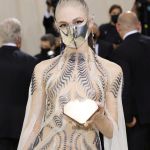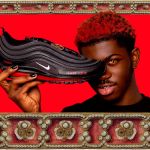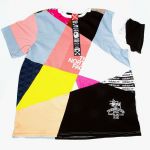
How MSCHF used streetwear to mock streetwear
After the Satan Shoes of Lil Nas X and the sword Grimes, the next goal of the collective is Mickey Mouse
September 17th, 2021
The sword that Grimes brought to the red carpet of the Met Gala 2021 as an unusual but completely fascinating accessory has a very particular story. The most attentive will have noticed that on the blade was engraved the inscription Crafted from a Colt AR-15 – which signaled how, originally, that sword had been an assault rifle, converted from a firearm to a medieval weapon by the MSCHF collective. That sword specifically, which is now on display at the Met, is part of the collective's Guns2Swords program, another of its irreverent initiatives dedicated to the thorny issue of gun control in America. The idea behind it is to turn guns into swords, thus allowing their owners to maintain the symbolic value of possessing a weapon without the danger of inadvertently shooting someone. On the website of the collective we read: «We propose that guns are a symbol that can be replaced by a different symbol without loss of satisfaction and at reduced threat to others. Guns2Swords substitutes the symbol for the real and neuters reality while salving the psyche».
A message full of irony, but it is also the most socially useful project that MSCHF has ever launched. But to understand what lies behind MSCHF you have to go back to March 2021 when the Brooklyn collective had risen to the headlines with the release of the Air Max 97 "Satan", the sneakers created with Lil Nas X and containing a drop of human blood (coming from the members of the MSCHF team) in the sole. With a limited release of 666 pairs, the Satans turned into a small event for the sneakerhead community, ending up on the one hand attracting the attention of names like Drake and Future, among the lucky few to take a pair home, but on the other sending Nike on a rampage for the infringement of its copyright.
Legal problems did not stop MSCHF, which ironically decided to find the target for its satire in another icon of pop culture of late capitalism: Mickey Mouse. The new drop announced by the collective, in fact, will respect (at least in a formal way) the rules of copyright, but in reality will try to circumvent them altogether. In short, a collector's figurine will be produced, whose final appearance will remain top-secret until January 2024, the date on which the copyright of Mickey Mouse will become public thus giving the possibility to anyone who wants to use it without any legal repercussions. In the meantime, however, it is possible to buy an NFT sarcastically called Famous Mouse that will entitle buyers to receive the collectible as soon as copyright laws fall.
At the crossroads of art and iconoclasty
In reality, the real goal of MSCHF is not so much to go to the backing of other intellectual property, but to emphasize the backwardness of the laws that regulate the modern concept of intellectual property, thus confirming the truth already expressed in the manifesto of the collective: to subvert the canons and laws of today's fashion through irony and creativity by deconstructing the status and value of those totems considered "untouchable" - a sort of iconoclastic war agl today's idols of capitalism. As explained by MSCHF, the first copyright laws in the United States protected works of art and other creations for only 14 years, while to meet the needs of Disney, in 1998 the Copyright Term Extension Act was passed, also known as the "Mickey Mouse Protection Act". In essence, the protest put in place through the sale of this collectible is against the overwhelming power of the big American and world corporations - and against their popular and commercial icons together.
Precisely for this reason the Famous Mouse project is only the latest in a series of provocative gestures put in place by MSCHF, short for Miscellaneous Mischief, whose final purpose is to highlight the paradoxes and contradictions of the current consumer society through irreverence and provocation. If according to Picasso great artists steal, then MSCHF represents the quintessence of the modern art world, especially considering the philosophical problems born of digital art, infinitely replicable and non-physical. If in the case of the Air Max 97, the Birkenstock made with Hermès bags, or the patchwork shirt that brought together ten brands in an impossible collaboration we can talk about a concrete and tangible object, in others we are faced with digital offers that are difficult to represent in reality: an NFT that acts as a proxy for a statue that does not exist; a software that generates photos of feet or a Windows laptop full of the most devastating malware that exists, capable of causing 95 billion dollars in financial damage.
A satire of streetwear
"We’re not necessarily here to make the world a better place", said the founder Gabriel Whaley to The Verge. "We’re not gonna be disillusioned like that. But we think that we have the ability to transform products and experiences around us into unexpected moments of surprise and delight". Judging by the data, Whaley is not the only one to believe in MSCHF, able to raise about 11.5 million dollars in investments since the fall of 2019. Although there is no consolidated marketing strategy, the model used by the collective takes up in many ways the one dear to the world of streetwear: weekly and limited drops, no restock and products that are difficult to imitate. This is the case of the aforementioned Satan Shoes, but also of their "holy" counterpart, the Air Max 97 with 60cc of water from the Jordan River inserted into the bearings. Sold for $1425, they sold out almost immediately. A satire directed at the world of streetwear and its exaggerations that, at a time when the fashion system desperately needs to reinvent itself, can represent a real lifeline for the future of the industry.




































.jpg)










(1).jpg)











































